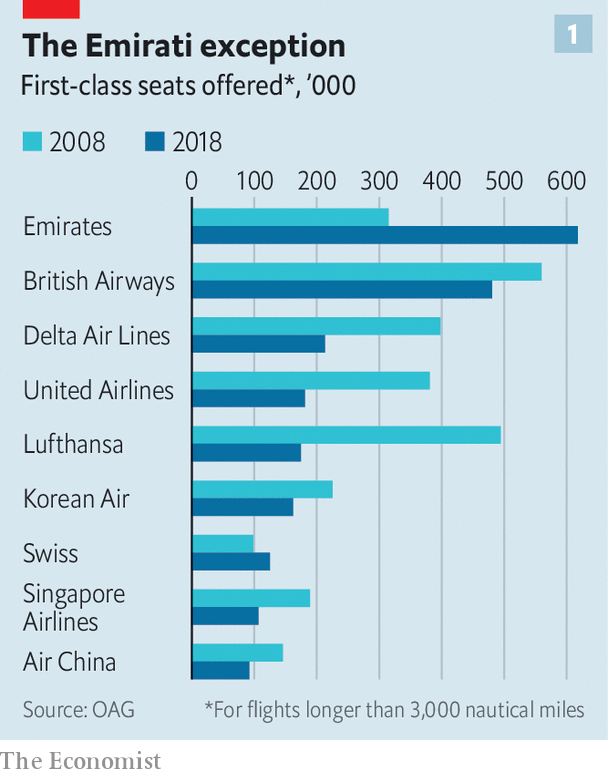 |
| Emirates First-Class |
 The
rows of hundreds of empty armchairs suggest that something is not quite right.
Airlines are falling out of love with first class. And that is true even of
Emirates, which sells far more first-class tickets than any other carrier (see chart 1).
The
rows of hundreds of empty armchairs suggest that something is not quite right.
Airlines are falling out of love with first class. And that is true even of
Emirates, which sells far more first-class tickets than any other carrier (see chart 1).The decline of first-class air travel seems at first glance surprising. Facilities onboard have never been so good. On its a380 superjumbos, Emirates first class provides in-flight showers. Moreover, the number of very rich people has risen sharply. Forbes, a magazine, estimates that the stock of billionaires has doubled to more than 2,100 over the past two decades. And the rest of the luxury-travel business is booming. Richard Clarke of Bernstein, a research firm, estimates that the number of luxury hotels in Asia could increase by as much as 168% over the next decade.
Even so, many analysts predict that first class will soon disappear. In America it is already almost extinct. Ten or so years ago almost all the many hundreds of long-haul aircraft based there offered first-class seating; now only about 20 do. Elsewhere on the majority of the most-travelled long-haul routes the number of first-class seats available has fallen sharply in the past decade (see chart 2).
When commercial aviation got going after the second world war there was only one class: first. Economy appeared in the 1950s. It was followed in the 1970s by business class and in the 1990s by premium economy, to fill the gap between business and cattle class.
Despite the proliferation
of cheaper seats, airlines still make a lot of their money from the more
expensive ones. High demand for flat beds on transatlantic flights is what has
saved European flag-carriers such as British Airways, Air France and Lufthansa
from going out of business.
 On short-haul
flights, the low-cost model has won. Most “first-class” passengers on these
routes now sit in seats with the same legroom as economy passengers, albeit
with an empty middle seat.
On short-haul
flights, the low-cost model has won. Most “first-class” passengers on these
routes now sit in seats with the same legroom as economy passengers, albeit
with an empty middle seat.
On longer
routes, new seats that turned into fully flat beds were a game-changer. These
were originally introduced by British Airways in first class in 1995, and much
sought after. If travellers could sleep comfortably in the sky, they could save the
cost of a hotel or, more importantly, a day’s working time. Some years later, in 2000 British
Airways launched a similar seat in business, and most carriers have
followed suit. That has weakened the case for flying first class. Most
companies think a flat bed in business class is good enough for their
employees.
Airlines that
offer first class say they still do so for two main reasons. The first is to
use upgrades from business class as an incentive for loyalty from both
corporate and individual customers. But as the gap between business and first
has narrowed, frequent flyers have begun to respond better to other incentives,
such as access to lounges or to special hotlines.
The second
reason for maintaining first class is also weakening because of the “halo
effect” an airline creates by advertising first-class facilities. Flyers begin to think economy on Emirates,
say, is fancier than on other airlines by association with features in its
first class, such as in-flight showers. This can be an effective marketing
tool. For instance, Etihad, a rival to Emirates in the Gulf, has probably had
more press coverage for its onboard first-class apartments called “The
Residence”, of which it has only ten, than all its 30,000 other seats combined.
Why do some
passengers still want to fly first rather than business? Privacy is one reason.
Smaller cabins and walled-off seats make it easier for a celebrity to fly
unnoticed. Another is flexibility.
First-class passengers want to sleep and eat when they choose, not on a
timetable set by cabin crew, as often happens in business class.
Additionally, first-
and business-class sales are threatened by private jets. These let executives
avoid the wait for a scheduled flight. It is also much quicker to pass through
security in a private-jet terminal than an airport. Moreover, executive jets
are becoming cheaper in relative terms. New shared-ownership and ride-hailing
services allow the cost of a private jet to be spread over many users.
Emirates lounge
manager in Dubai sounds perplexed: “You need to do something different to make
first class worth it.”